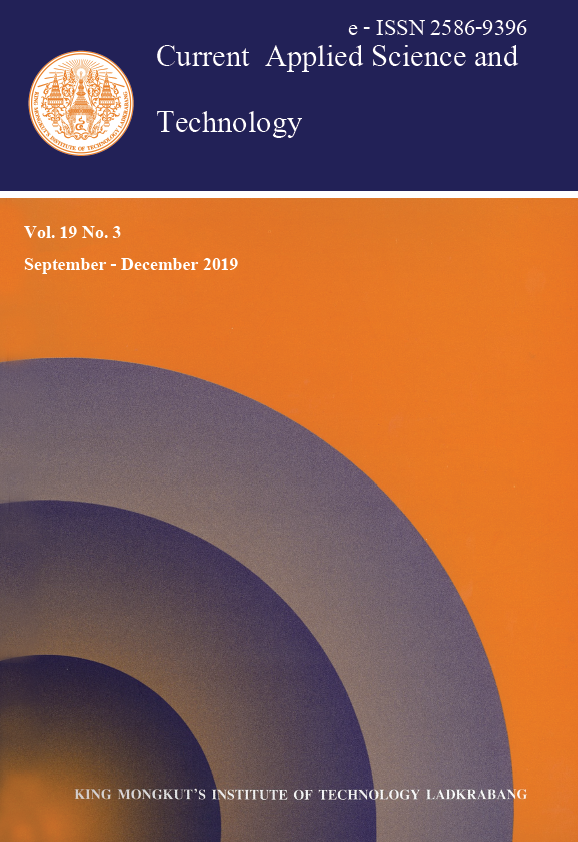Control of Pathogenic Bacteria in Cooked Duck Blood Curd using Sodium Diacetate and Sodium Chloride
Main Article Content
Abstract
The effects of sodium diacetate (SD) and sodium chloride (NaCl) on growth inhibition of four bacterial strains: Escherichia coli, Salmonella Typhimurium, Pseudomonas fluorescens and Staphylococcus aureus were investigated by determining the minimum inhibitory concentration and bactericidal concentrations (MIC and MBC), fractional inhibitory and bactericidal concentration index (FICI and FBCI) and survival of these pathogenic bacteria in cooked duck blood curd. SD provided greater overall inhibition to all tested bacterial strains in comparison with NaCl. The effect of SD + NaCl in combination was partially synergistic or synergistic against these pathogenic bacterial, exhibiting FICI and FBCI of 0.75 and 0.25 respectively for E. coli, 0.62 and 0.62 respectively for S. Typhimurium, 1.00 and 0.62 respectively for P. fluorescens and 0.50 and 0.37 respectively for S. aureus. For cooked duck blood curd, 0.15%(w/v) SD + 1.25%(w/v) NaCl in combination reduced E. coli, Salmonella spp., Pseudomonas spp. and S. aureus (p < 0.05) in the range of 0.63 - 1.10 log cycles and controlled the growth of all four bacteria more than the control sample (P < 0.05) did. Furthermore, the 0.15%(w/v) SD + 1.25%(w/v) NaCl combination controlled the growth of these bacteria in cooked duck blood curd for 6 days of storage, except in the case of E. coli, for which growth was controlled for 4 days of storage. All experimental results were compared to the control sample before storage (p > 0.05). The results indicate that SD in combination with NaCl can be incorporated into cooked duck blood curd to effectively reduce and control growth of pathogenic bacteria at 10oC of storage.
Keywords: organic acid salt; pathogenic bacteria; cooked duck blood curd; cold storage
*Corresponding author: Tel.: 011-662-329-8000 Ext. 6047 Fax: 011-662-329-8519
E-mail: putang3009@hotmail.com
Article Details
Copyright Transfer Statement
The copyright of this article is transferred to Current Applied Science and Technology journal with effect if and when the article is accepted for publication. The copyright transfer covers the exclusive right to reproduce and distribute the article, including reprints, translations, photographic reproductions, electronic form (offline, online) or any other reproductions of similar nature.
The author warrants that this contribution is original and that he/she has full power to make this grant. The author signs for and accepts responsibility for releasing this material on behalf of any and all co-authors.
Here is the link for download: Copyright transfer form.pdf
References
Wang, P., Han, M.-Y., Dong, Q.-L., Xu, X.-L., Zhou, G.-H. and Lu, S.-L., 2010. Principal component analysis for textural properties of selected blood curd. Journal of Texture Studies, 41(6), 757-773.
Shelef, L.A. and Addala, L., 1994. Inhibition of Listeria monocytogenes and other bacteria by sodium diacetate. Journal of Food Safety, 14(2), 103-115.
Nanasombat, S. and Chooprang, K., 2009. Control of pathogenic bacteria in raw pork using organic acid salts in combination with freezing and thawing. Kasetsart Journal (Natural Science), 43(2), 576-583.
Health Canada, 2016. List of Permitted Preservatives (Lists of Permitted Food Additives). [online] Available at: http://www.hc-sc.gc.ca/fn-an/securit/addit/list/11-preserv-conserv-eng.php
Food and Drug Administration, 2016. Sodium diacetate: 21CFR184.1754. CFR - Code of Federal Regulations Title 21. [online] Available at: https://www.accessdata.fda.gov/scripts/ cdrh/cfdocs/cfcfr/CFRSearch.cfm?fr=184.1754
Hajmeer, M., Ceylan, E., Marsden, J.L. and Fung, D.Y. 2006. Impact of sodium chloride on E. coli O157:H7 and S. aureus analysed using transmission electron microscopy. Food Microbiology, 23(5), 446-452.
Krämer, R., 2010. Bacterial stimulus perception and signal transduction: Response to osmotic stress. The Chemical Record, 10(4), 217-229.
CLSI, 2002. Reference method for dilution antimicrobial susceptibility tests for bacteria that grow aerobically. Approved Standard M7-A4. Wayne, Pa: Clinical Laboratory Standards Institute.
Tangwatcharin, P. and Prapaporn, K., 2012. Activity of virgin coconut oil, lauric acid or monolaurin in combination with lactic acid against Staphylococcus aureus. Southeast Asian Journal of Tropical Medicine and Public Health, 43(4), 969-985.
Bacteriological Analytical Manual (BAM), 2002. Escherichia coli. U.S. Food and Drug Administration. [Online] Available at: https://www.fda.gov/Food/FoodScienceResearch/ LaboratoryMethods/ucm064948.htm
ISO 6579, 2002. Microbiology of Food and Animal Feeding Stuffs-Horizontal Method for the Detection. 4th ed. Geneva: International Organization for Standardization.
Rajmohan, S., Dodd, C.E.R. and Waites, W.M., 2002. Enzymes from isolates of Pseudomonas fluorescens involved in food spoilage. Journal of Applied Microbiology, 93(1), 205-213.
Bacteriological Analytical Manual (BAM), 2001. Staphylococcus aureus U.S. Food and Drug Administration. [online] Available at: http://www.fda.gov/Food/FoodScienceResearch/ LaboratoryMethods/ucm071429.htm
Collins, C.H., Lyne, P.M. and Grange, J.M., 1991. Collins and Lyne’s Microbiological Methods. 6th ed. Oxford: Butterworth.
SAS Institute Inc., 2002. SAS Version 9.0. Cary, NC: SAS Institute.
Thayer, D.W., Muller, W.S., Buchanan, R.L. and Phillips, J.G., 1987. Effect of NaCl, pH, temperature, and atmosphere on growth of Salmonella typhimurium in glucose-mineral salts medium. Applied and Environmental Microbiology, 53(6), 1311-1315.
Zambonelli, C., Papa, F., Romano, P., Suzzi, G. and Grazia, L., 1992. Microbiologia dei Salumi. Bologna: Calderini Edagricole.
Silva, E.N.G., Almeida, R.C.C., Figueiredo A.C.L. and Miranda, F.A., 2012. Effects of salts of organic acids on the survival of Listeria monocytogenes in soft cheeses. International Journal of Food Science and Technology, 47(9), 1819-1825.
Hwang, C.A. and Tamplin, M.L., 2007. Modeling the lag phase and growth rate of Listeria monocytogenes in ground ham containing sodium lactate and sodium diacetate at various storage temperatures. Journal of Food Science, 72(7), M246-M253.


